CHC52015 Diploma of Community Services: Case Management Workbook
VerifiedAdded on 2023/06/10
|52
|10631
|242
Homework Assignment
AI Summary
This assignment is a comprehensive workbook designed for students pursuing a Diploma of Community Services (CHC52015), focusing on case management and professional development. The workbook covers various aspects, including legal and ethical considerations like codes of practice, duty of care, and the rights and responsibilities of workers and employers, alongside work role boundaries. It incorporates Kolb's experiential learning cycle to enhance understanding and application of case management principles. The assignment includes knowledge assessments with short-answer questions and practical assessments involving research, planning, and reflection on personal and professional development within a community services context. The workbook aims to equip students with the necessary skills and knowledge to excel in their roles as case managers, emphasizing the importance of continuous learning and ethical practice.
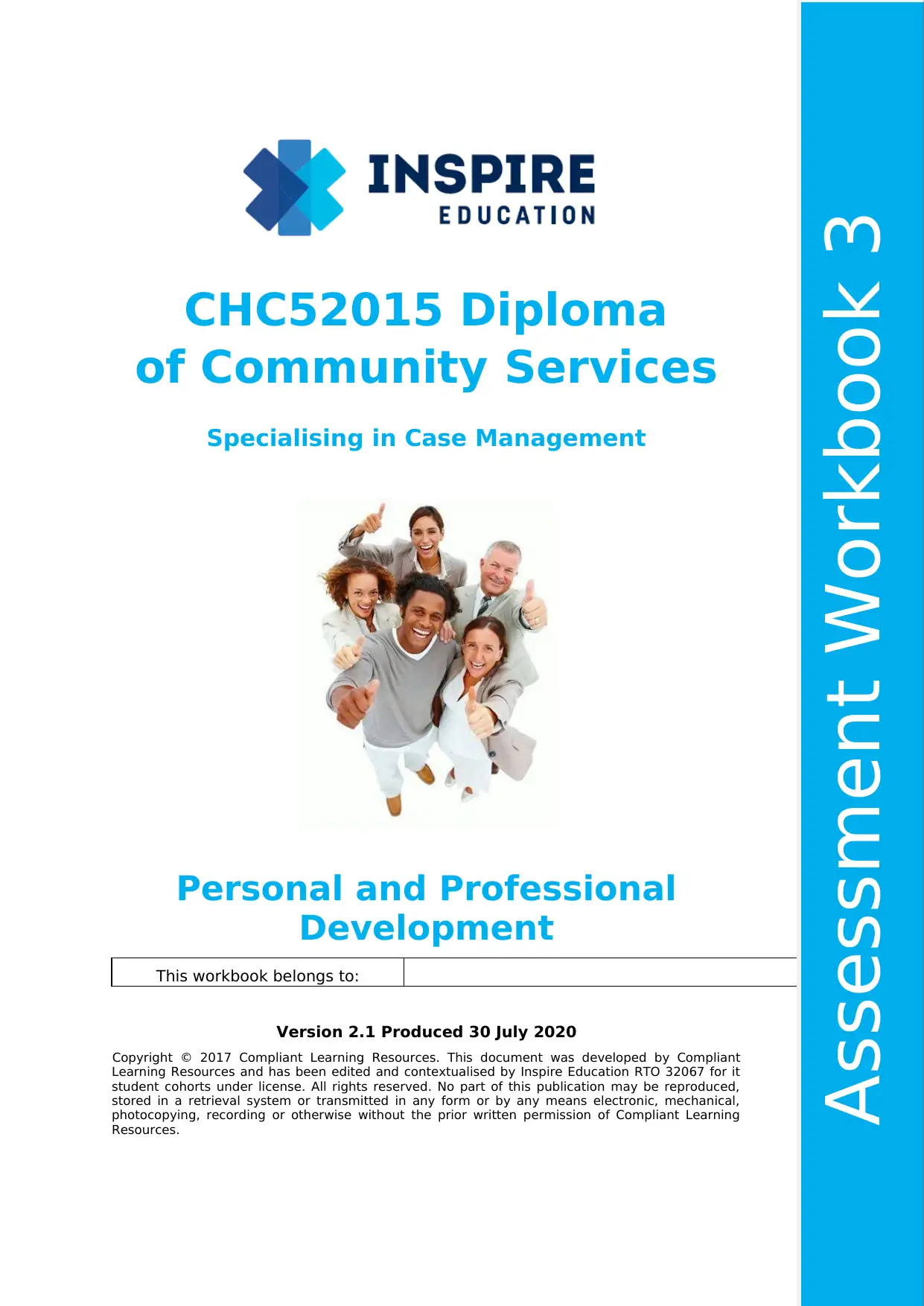
CHC52015 Diploma
of Community Services
Specialising in Case Management
Personal and Professional
Development
This workbook belongs to:
Version 2.1 Produced 30 July 2020
Copyright © 2017 Compliant Learning Resources. This document was developed by Compliant
Learning Resources and has been edited and contextualised by Inspire Education RTO 32067 for it
student cohorts under license. All rights reserved. No part of this publication may be reproduced,
stored in a retrieval system or transmitted in any form or by any means electronic, mechanical,
photocopying, recording or otherwise without the prior written permission of Compliant Learning
Resources.
Assessment Workbook 3Assessment Workbook 3
of Community Services
Specialising in Case Management
Personal and Professional
Development
This workbook belongs to:
Version 2.1 Produced 30 July 2020
Copyright © 2017 Compliant Learning Resources. This document was developed by Compliant
Learning Resources and has been edited and contextualised by Inspire Education RTO 32067 for it
student cohorts under license. All rights reserved. No part of this publication may be reproduced,
stored in a retrieval system or transmitted in any form or by any means electronic, mechanical,
photocopying, recording or otherwise without the prior written permission of Compliant Learning
Resources.
Assessment Workbook 3Assessment Workbook 3
Paraphrase This Document
Need a fresh take? Get an instant paraphrase of this document with our AI Paraphraser
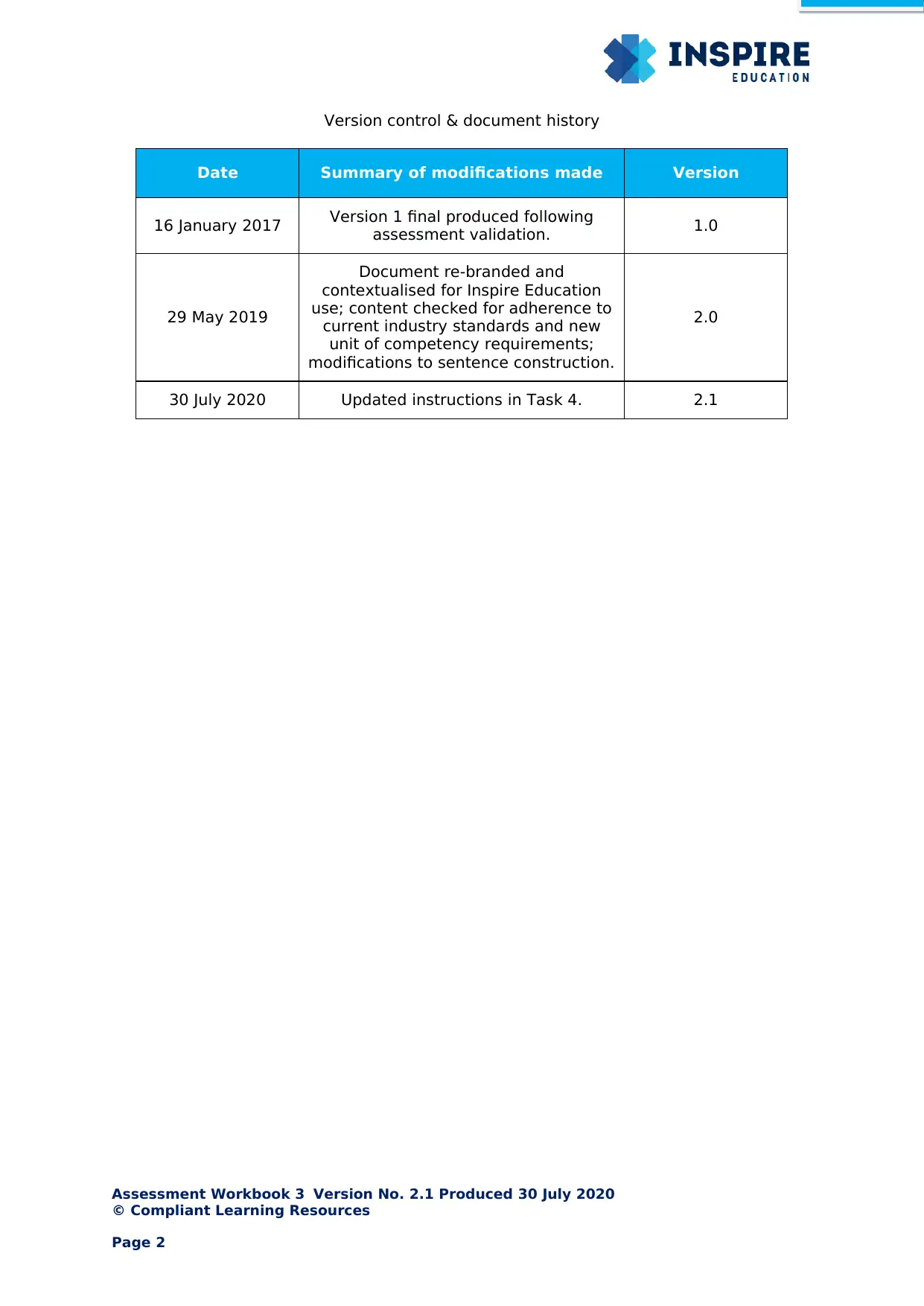
Version control & document history
Date Summary of modifications made Version
16 January 2017 Version 1 final produced following
assessment validation. 1.0
29 May 2019
Document re-branded and
contextualised for Inspire Education
use; content checked for adherence to
current industry standards and new
unit of competency requirements;
modifications to sentence construction.
2.0
30 July 2020 Updated instructions in Task 4. 2.1
Assessment Workbook 3 Version No. 2.1 Produced 30 July 2020
© Compliant Learning Resources
Page 2
Date Summary of modifications made Version
16 January 2017 Version 1 final produced following
assessment validation. 1.0
29 May 2019
Document re-branded and
contextualised for Inspire Education
use; content checked for adherence to
current industry standards and new
unit of competency requirements;
modifications to sentence construction.
2.0
30 July 2020 Updated instructions in Task 4. 2.1
Assessment Workbook 3 Version No. 2.1 Produced 30 July 2020
© Compliant Learning Resources
Page 2
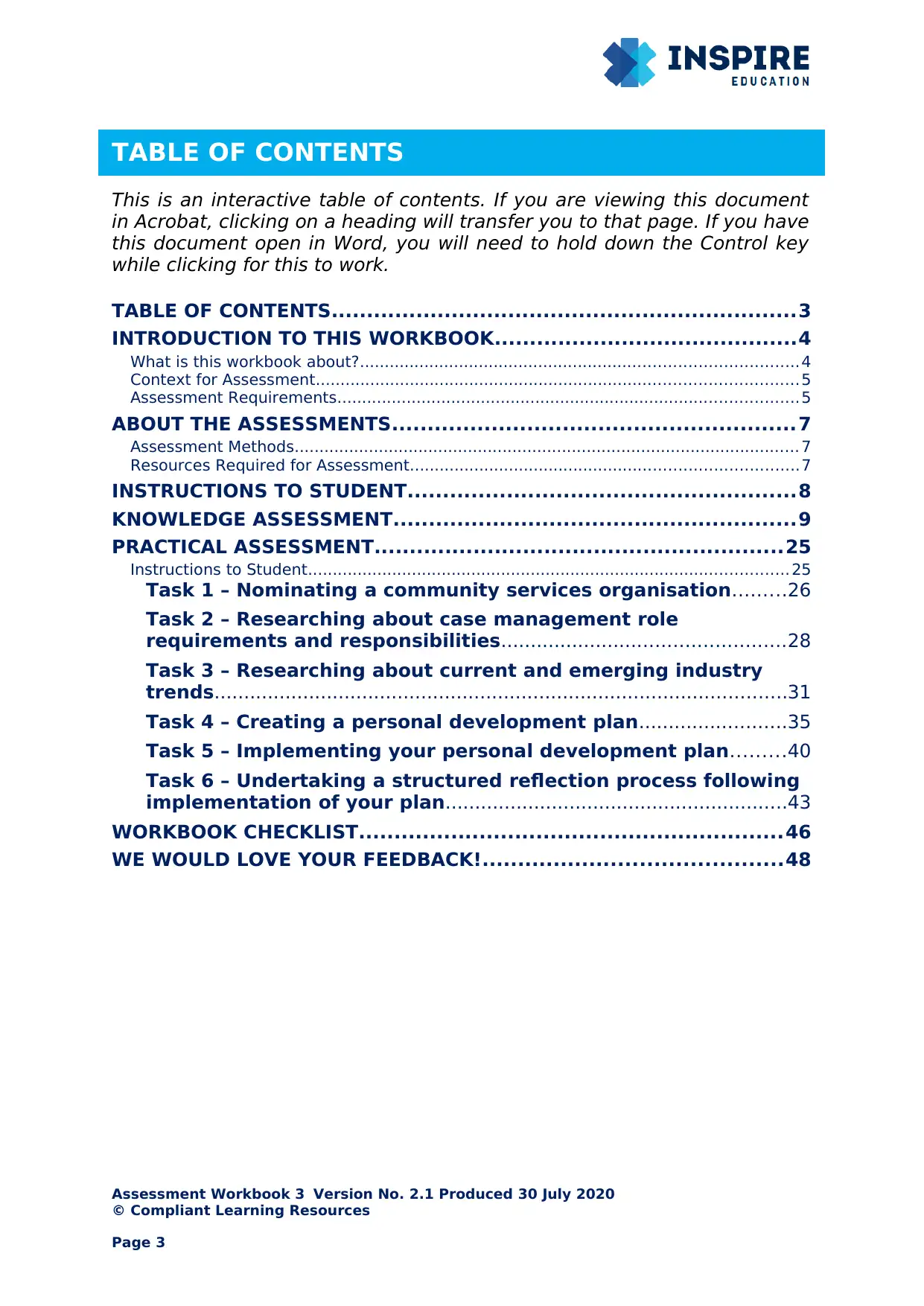
TABLE OF CONTENTS
This is an interactive table of contents. If you are viewing this document
in Acrobat, clicking on a heading will transfer you to that page. If you have
this document open in Word, you will need to hold down the Control key
while clicking for this to work.
TABLE OF CONTENTS..................................................................3
INTRODUCTION TO THIS WORKBOOK...........................................4
What is this workbook about?........................................................................................4
Context for Assessment.................................................................................................5
Assessment Requirements.............................................................................................5
ABOUT THE ASSESSMENTS.........................................................7
Assessment Methods...................................................................................................... 7
Resources Required for Assessment..............................................................................7
INSTRUCTIONS TO STUDENT.......................................................8
KNOWLEDGE ASSESSMENT.........................................................9
PRACTICAL ASSESSMENT..........................................................25
Instructions to Student................................................................................................. 25
Task 1 – Nominating a community services organisation.........26
Task 2 – Researching about case management role
requirements and responsibilities................................................28
Task 3 – Researching about current and emerging industry
trends.................................................................................................31
Task 4 – Creating a personal development plan.........................35
Task 5 – Implementing your personal development plan.........40
Task 6 – Undertaking a structured reflection process following
implementation of your plan..........................................................43
WORKBOOK CHECKLIST............................................................46
WE WOULD LOVE YOUR FEEDBACK!..........................................48
Assessment Workbook 3 Version No. 2.1 Produced 30 July 2020
© Compliant Learning Resources
Page 3
This is an interactive table of contents. If you are viewing this document
in Acrobat, clicking on a heading will transfer you to that page. If you have
this document open in Word, you will need to hold down the Control key
while clicking for this to work.
TABLE OF CONTENTS..................................................................3
INTRODUCTION TO THIS WORKBOOK...........................................4
What is this workbook about?........................................................................................4
Context for Assessment.................................................................................................5
Assessment Requirements.............................................................................................5
ABOUT THE ASSESSMENTS.........................................................7
Assessment Methods...................................................................................................... 7
Resources Required for Assessment..............................................................................7
INSTRUCTIONS TO STUDENT.......................................................8
KNOWLEDGE ASSESSMENT.........................................................9
PRACTICAL ASSESSMENT..........................................................25
Instructions to Student................................................................................................. 25
Task 1 – Nominating a community services organisation.........26
Task 2 – Researching about case management role
requirements and responsibilities................................................28
Task 3 – Researching about current and emerging industry
trends.................................................................................................31
Task 4 – Creating a personal development plan.........................35
Task 5 – Implementing your personal development plan.........40
Task 6 – Undertaking a structured reflection process following
implementation of your plan..........................................................43
WORKBOOK CHECKLIST............................................................46
WE WOULD LOVE YOUR FEEDBACK!..........................................48
Assessment Workbook 3 Version No. 2.1 Produced 30 July 2020
© Compliant Learning Resources
Page 3
⊘ This is a preview!⊘
Do you want full access?
Subscribe today to unlock all pages.

Trusted by 1+ million students worldwide
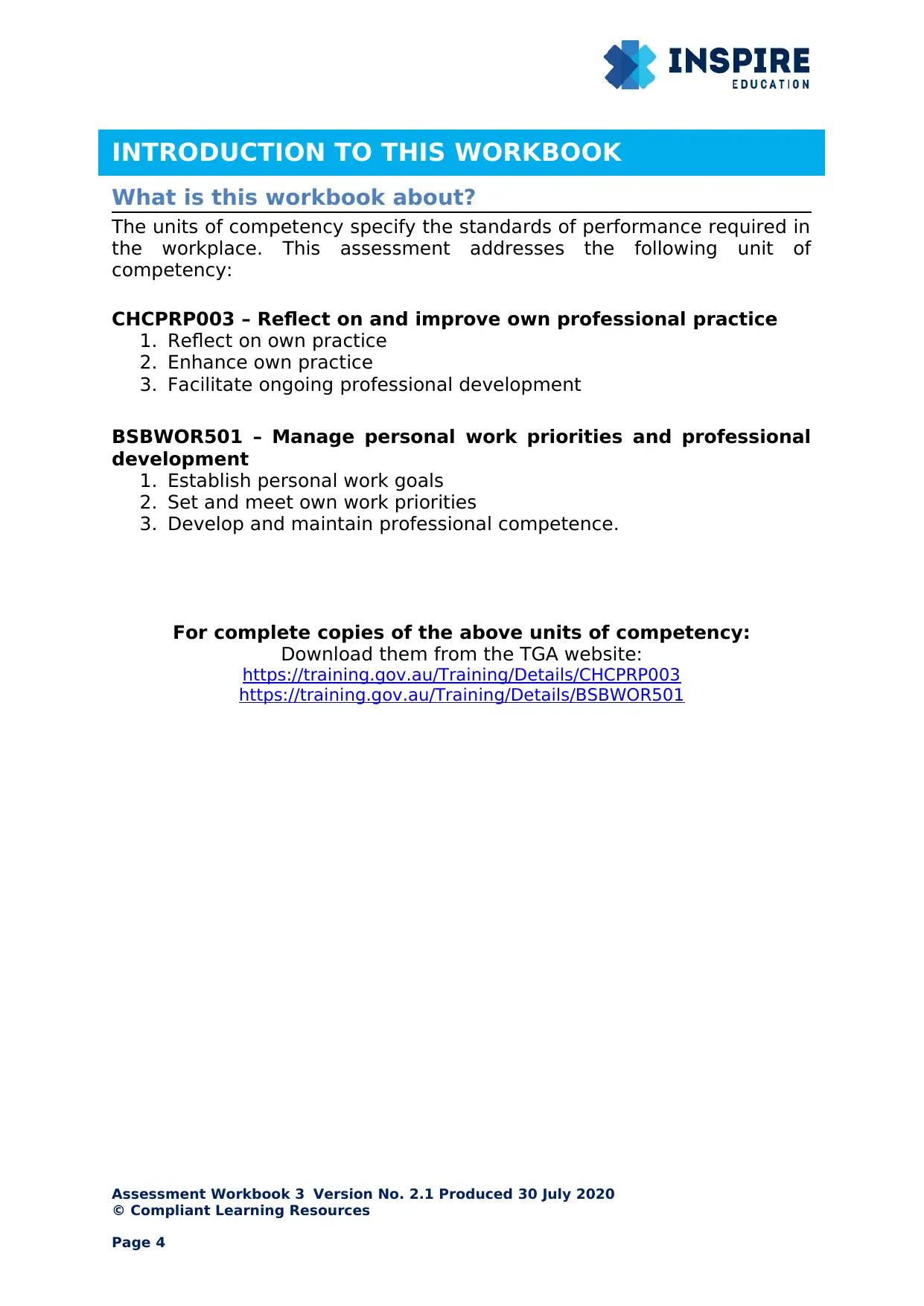
INTRODUCTION TO THIS WORKBOOK
What is this workbook about?
The units of competency specify the standards of performance required in
the workplace. This assessment addresses the following unit of
competency:
CHCPRP003 – Reflect on and improve own professional practice
1. Reflect on own practice
2. Enhance own practice
3. Facilitate ongoing professional development
BSBWOR501 – Manage personal work priorities and professional
development
1. Establish personal work goals
2. Set and meet own work priorities
3. Develop and maintain professional competence.
For complete copies of the above units of competency:
Download them from the TGA website:
https://training.gov.au/Training/Details/CHCPRP003
https://training.gov.au/Training/Details/BSBWOR501
Assessment Workbook 3 Version No. 2.1 Produced 30 July 2020
© Compliant Learning Resources
Page 4
What is this workbook about?
The units of competency specify the standards of performance required in
the workplace. This assessment addresses the following unit of
competency:
CHCPRP003 – Reflect on and improve own professional practice
1. Reflect on own practice
2. Enhance own practice
3. Facilitate ongoing professional development
BSBWOR501 – Manage personal work priorities and professional
development
1. Establish personal work goals
2. Set and meet own work priorities
3. Develop and maintain professional competence.
For complete copies of the above units of competency:
Download them from the TGA website:
https://training.gov.au/Training/Details/CHCPRP003
https://training.gov.au/Training/Details/BSBWOR501
Assessment Workbook 3 Version No. 2.1 Produced 30 July 2020
© Compliant Learning Resources
Page 4
Paraphrase This Document
Need a fresh take? Get an instant paraphrase of this document with our AI Paraphraser
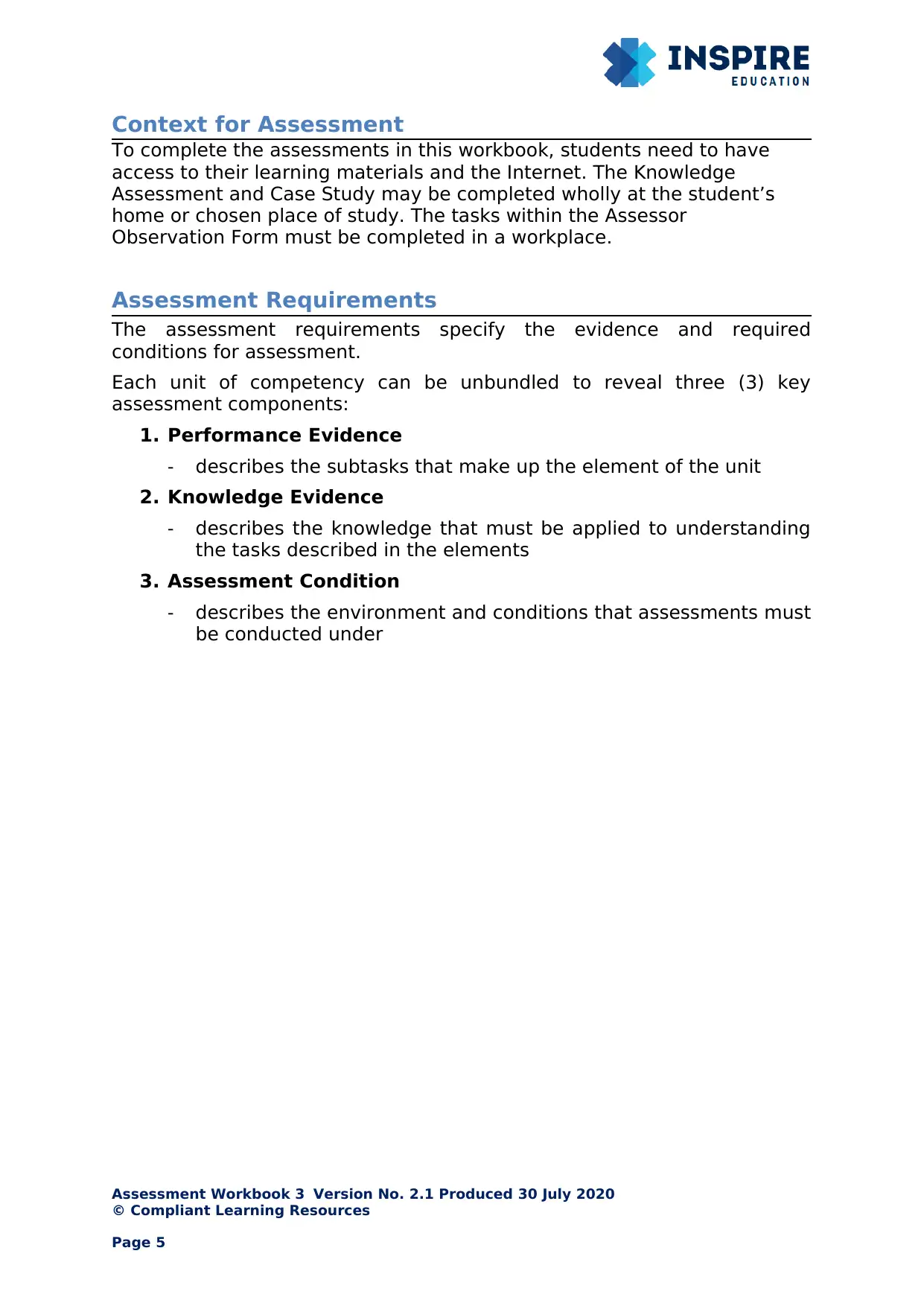
Context for Assessment
To complete the assessments in this workbook, students need to have
access to their learning materials and the Internet. The Knowledge
Assessment and Case Study may be completed wholly at the student’s
home or chosen place of study. The tasks within the Assessor
Observation Form must be completed in a workplace.
Assessment Requirements
The assessment requirements specify the evidence and required
conditions for assessment.
Each unit of competency can be unbundled to reveal three (3) key
assessment components:
1. Performance Evidence
- describes the subtasks that make up the element of the unit
2. Knowledge Evidence
- describes the knowledge that must be applied to understanding
the tasks described in the elements
3. Assessment Condition
- describes the environment and conditions that assessments must
be conducted under
Assessment Workbook 3 Version No. 2.1 Produced 30 July 2020
© Compliant Learning Resources
Page 5
To complete the assessments in this workbook, students need to have
access to their learning materials and the Internet. The Knowledge
Assessment and Case Study may be completed wholly at the student’s
home or chosen place of study. The tasks within the Assessor
Observation Form must be completed in a workplace.
Assessment Requirements
The assessment requirements specify the evidence and required
conditions for assessment.
Each unit of competency can be unbundled to reveal three (3) key
assessment components:
1. Performance Evidence
- describes the subtasks that make up the element of the unit
2. Knowledge Evidence
- describes the knowledge that must be applied to understanding
the tasks described in the elements
3. Assessment Condition
- describes the environment and conditions that assessments must
be conducted under
Assessment Workbook 3 Version No. 2.1 Produced 30 July 2020
© Compliant Learning Resources
Page 5
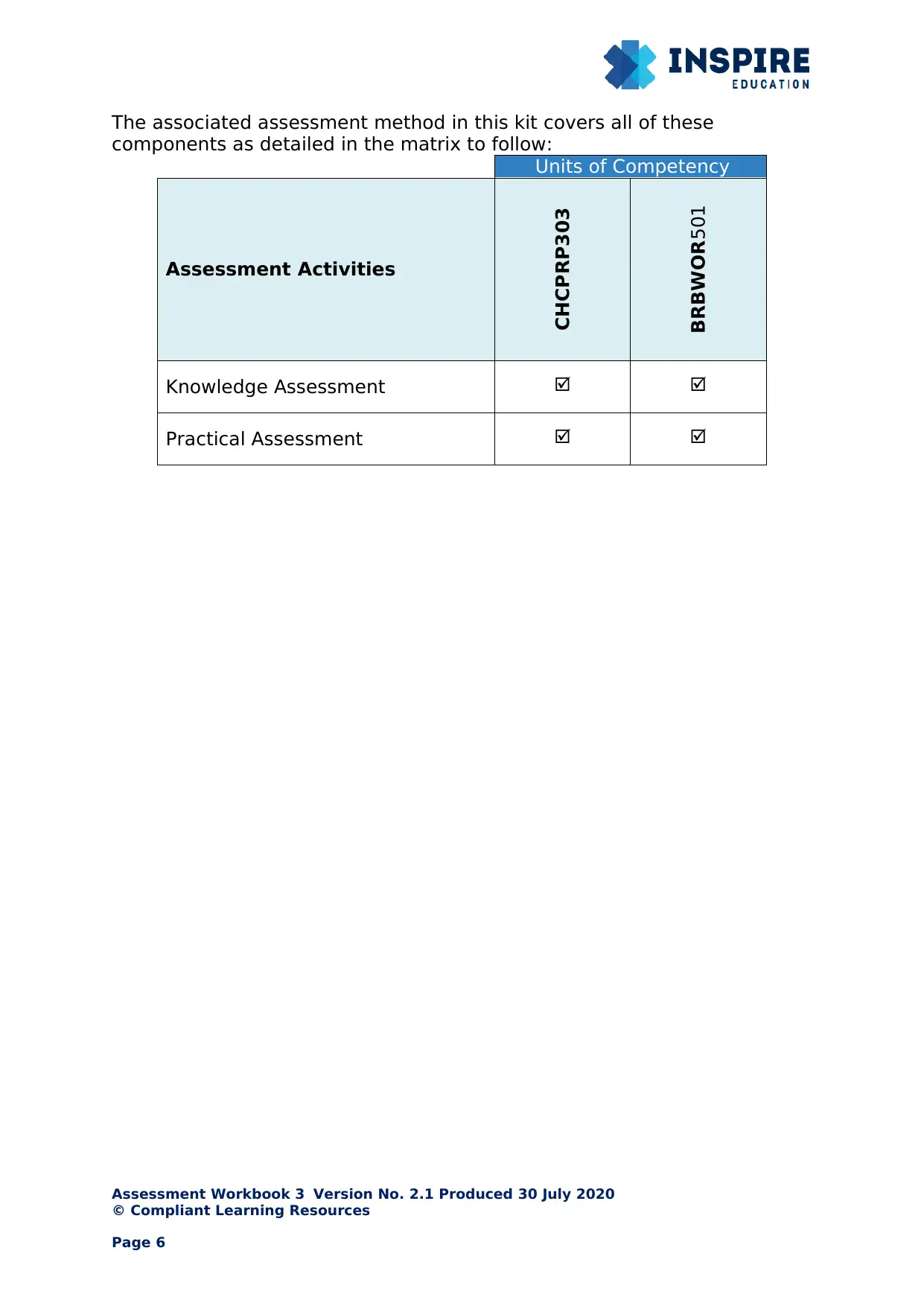
The associated assessment method in this kit covers all of these
components as detailed in the matrix to follow:
Units of Competency
Assessment Activities
CHCPRP303
BRBWOR501
Knowledge Assessment
Practical Assessment
Assessment Workbook 3 Version No. 2.1 Produced 30 July 2020
© Compliant Learning Resources
Page 6
components as detailed in the matrix to follow:
Units of Competency
Assessment Activities
CHCPRP303
BRBWOR501
Knowledge Assessment
Practical Assessment
Assessment Workbook 3 Version No. 2.1 Produced 30 July 2020
© Compliant Learning Resources
Page 6
⊘ This is a preview!⊘
Do you want full access?
Subscribe today to unlock all pages.

Trusted by 1+ million students worldwide
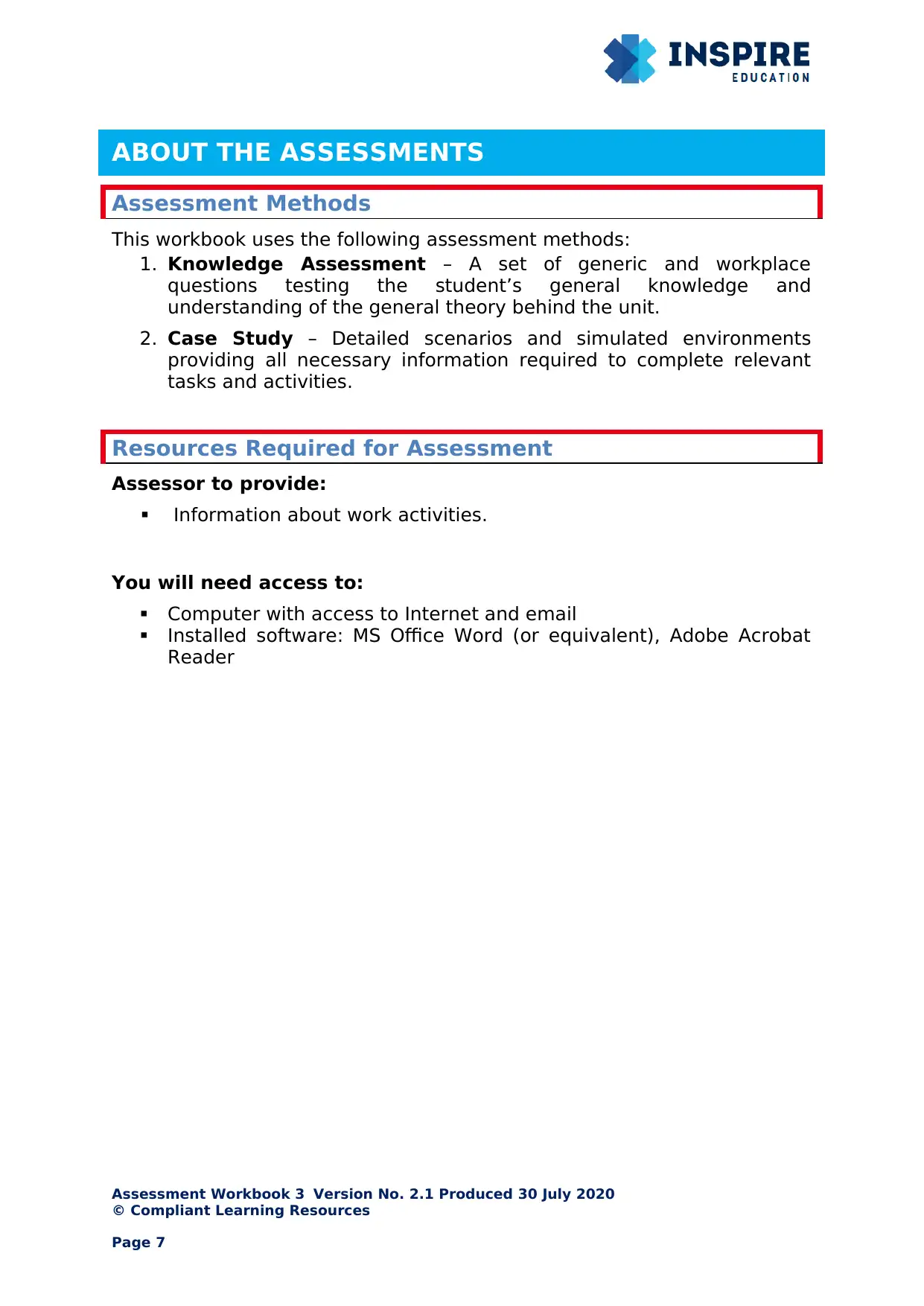
ABOUT THE ASSESSMENTS
Assessment Methods
This workbook uses the following assessment methods:
1. Knowledge Assessment – A set of generic and workplace
questions testing the student’s general knowledge and
understanding of the general theory behind the unit.
2. Case Study – Detailed scenarios and simulated environments
providing all necessary information required to complete relevant
tasks and activities.
Resources Required for Assessment
Assessor to provide:
Information about work activities.
You will need access to:
Computer with access to Internet and email
Installed software: MS Office Word (or equivalent), Adobe Acrobat
Reader
Assessment Workbook 3 Version No. 2.1 Produced 30 July 2020
© Compliant Learning Resources
Page 7
Assessment Methods
This workbook uses the following assessment methods:
1. Knowledge Assessment – A set of generic and workplace
questions testing the student’s general knowledge and
understanding of the general theory behind the unit.
2. Case Study – Detailed scenarios and simulated environments
providing all necessary information required to complete relevant
tasks and activities.
Resources Required for Assessment
Assessor to provide:
Information about work activities.
You will need access to:
Computer with access to Internet and email
Installed software: MS Office Word (or equivalent), Adobe Acrobat
Reader
Assessment Workbook 3 Version No. 2.1 Produced 30 July 2020
© Compliant Learning Resources
Page 7
Paraphrase This Document
Need a fresh take? Get an instant paraphrase of this document with our AI Paraphraser
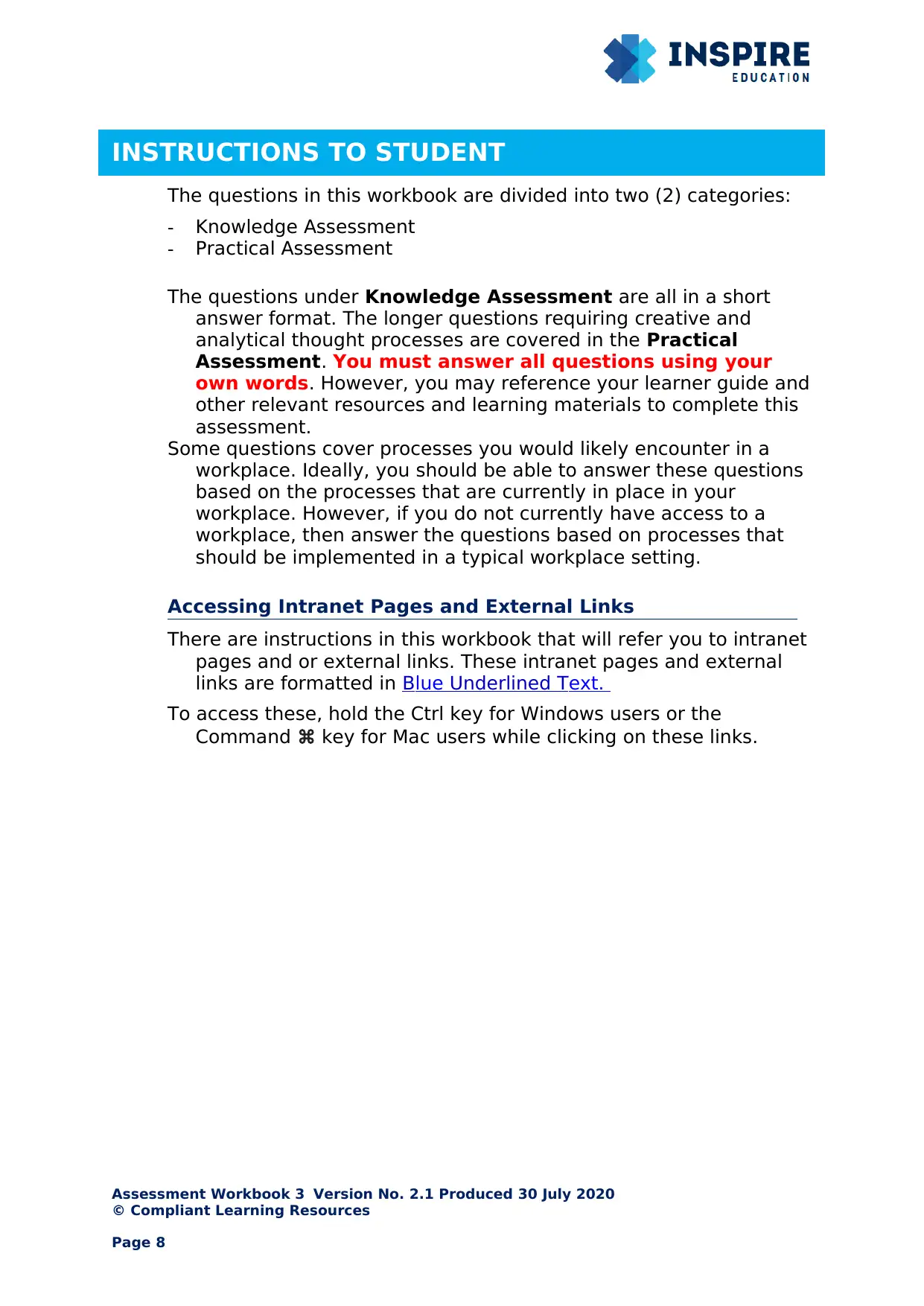
INSTRUCTIONS TO STUDENT
The questions in this workbook are divided into two (2) categories:
- Knowledge Assessment
- Practical Assessment
The questions under Knowledge Assessment are all in a short
answer format. The longer questions requiring creative and
analytical thought processes are covered in the Practical
Assessment. You must answer all questions using your
own words. However, you may reference your learner guide and
other relevant resources and learning materials to complete this
assessment.
Some questions cover processes you would likely encounter in a
workplace. Ideally, you should be able to answer these questions
based on the processes that are currently in place in your
workplace. However, if you do not currently have access to a
workplace, then answer the questions based on processes that
should be implemented in a typical workplace setting.
Accessing Intranet Pages and External Links
There are instructions in this workbook that will refer you to intranet
pages and or external links. These intranet pages and external
links are formatted in Blue Underlined Text.
To access these, hold the Ctrl key for Windows users or the
Command ⌘ key for Mac users while clicking on these links.
Assessment Workbook 3 Version No. 2.1 Produced 30 July 2020
© Compliant Learning Resources
Page 8
The questions in this workbook are divided into two (2) categories:
- Knowledge Assessment
- Practical Assessment
The questions under Knowledge Assessment are all in a short
answer format. The longer questions requiring creative and
analytical thought processes are covered in the Practical
Assessment. You must answer all questions using your
own words. However, you may reference your learner guide and
other relevant resources and learning materials to complete this
assessment.
Some questions cover processes you would likely encounter in a
workplace. Ideally, you should be able to answer these questions
based on the processes that are currently in place in your
workplace. However, if you do not currently have access to a
workplace, then answer the questions based on processes that
should be implemented in a typical workplace setting.
Accessing Intranet Pages and External Links
There are instructions in this workbook that will refer you to intranet
pages and or external links. These intranet pages and external
links are formatted in Blue Underlined Text.
To access these, hold the Ctrl key for Windows users or the
Command ⌘ key for Mac users while clicking on these links.
Assessment Workbook 3 Version No. 2.1 Produced 30 July 2020
© Compliant Learning Resources
Page 8
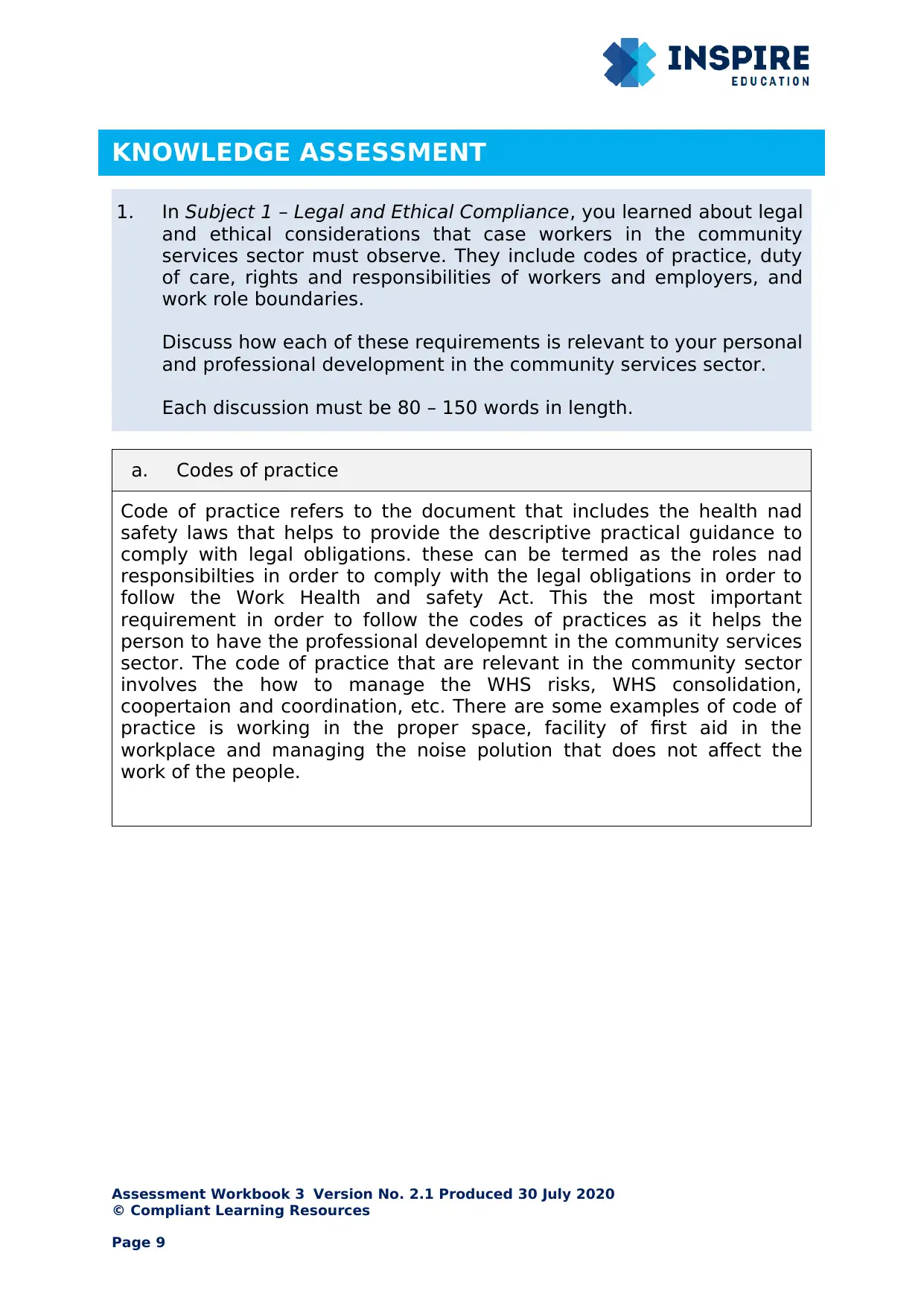
KNOWLEDGE ASSESSMENT
1. In Subject 1 – Legal and Ethical Compliance, you learned about legal
and ethical considerations that case workers in the community
services sector must observe. They include codes of practice, duty
of care, rights and responsibilities of workers and employers, and
work role boundaries.
Discuss how each of these requirements is relevant to your personal
and professional development in the community services sector.
Each discussion must be 80 – 150 words in length.
a. Codes of practice
Code of practice refers to the document that includes the health nad
safety laws that helps to provide the descriptive practical guidance to
comply with legal obligations. these can be termed as the roles nad
responsibilties in order to comply with the legal obligations in order to
follow the Work Health and safety Act. This the most important
requirement in order to follow the codes of practices as it helps the
person to have the professional developemnt in the community services
sector. The code of practice that are relevant in the community sector
involves the how to manage the WHS risks, WHS consolidation,
coopertaion and coordination, etc. There are some examples of code of
practice is working in the proper space, facility of first aid in the
workplace and managing the noise polution that does not affect the
work of the people.
Assessment Workbook 3 Version No. 2.1 Produced 30 July 2020
© Compliant Learning Resources
Page 9
1. In Subject 1 – Legal and Ethical Compliance, you learned about legal
and ethical considerations that case workers in the community
services sector must observe. They include codes of practice, duty
of care, rights and responsibilities of workers and employers, and
work role boundaries.
Discuss how each of these requirements is relevant to your personal
and professional development in the community services sector.
Each discussion must be 80 – 150 words in length.
a. Codes of practice
Code of practice refers to the document that includes the health nad
safety laws that helps to provide the descriptive practical guidance to
comply with legal obligations. these can be termed as the roles nad
responsibilties in order to comply with the legal obligations in order to
follow the Work Health and safety Act. This the most important
requirement in order to follow the codes of practices as it helps the
person to have the professional developemnt in the community services
sector. The code of practice that are relevant in the community sector
involves the how to manage the WHS risks, WHS consolidation,
coopertaion and coordination, etc. There are some examples of code of
practice is working in the proper space, facility of first aid in the
workplace and managing the noise polution that does not affect the
work of the people.
Assessment Workbook 3 Version No. 2.1 Produced 30 July 2020
© Compliant Learning Resources
Page 9
⊘ This is a preview!⊘
Do you want full access?
Subscribe today to unlock all pages.

Trusted by 1+ million students worldwide
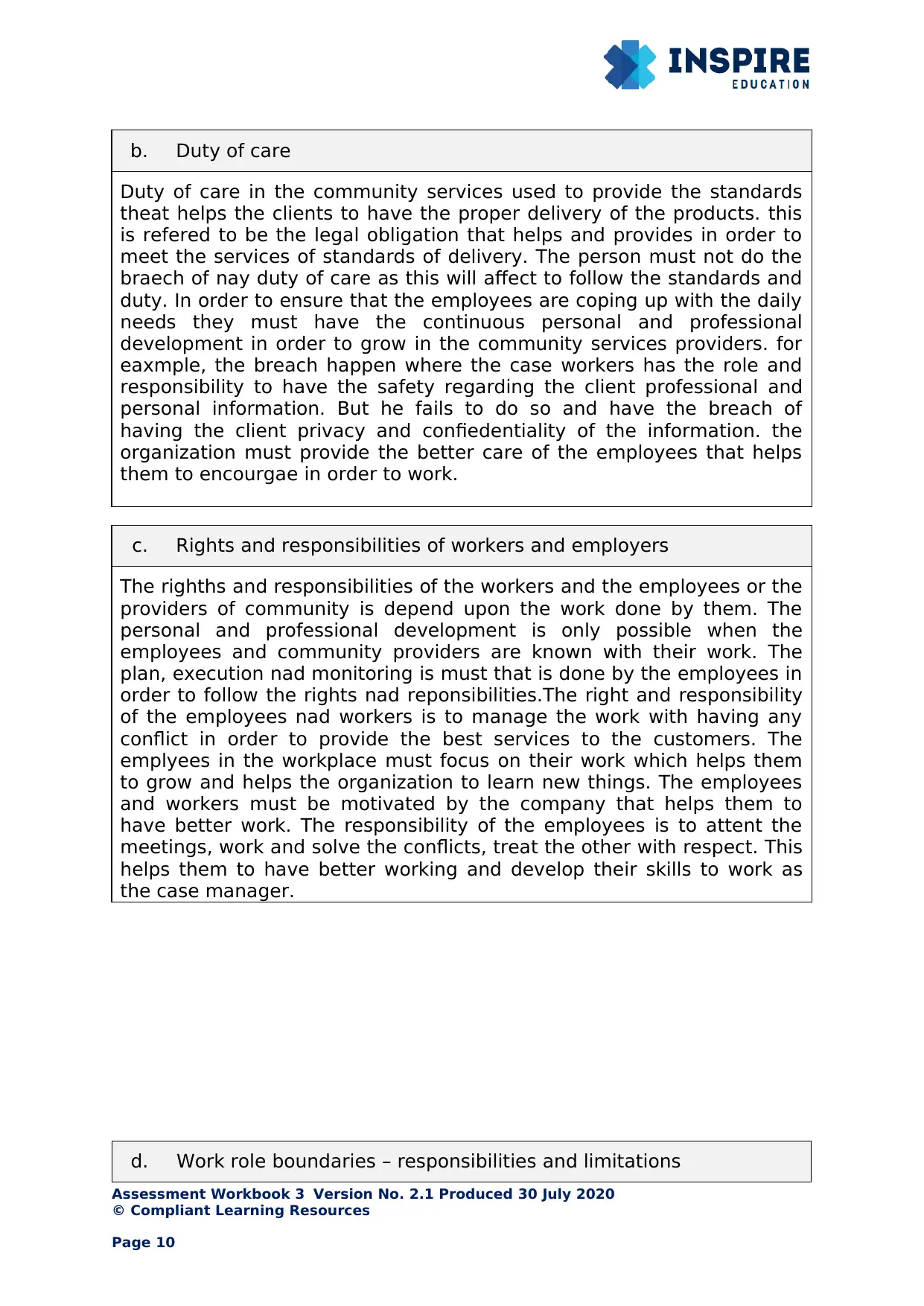
b. Duty of care
Duty of care in the community services used to provide the standards
theat helps the clients to have the proper delivery of the products. this
is refered to be the legal obligation that helps and provides in order to
meet the services of standards of delivery. The person must not do the
braech of nay duty of care as this will affect to follow the standards and
duty. In order to ensure that the employees are coping up with the daily
needs they must have the continuous personal and professional
development in order to grow in the community services providers. for
eaxmple, the breach happen where the case workers has the role and
responsibility to have the safety regarding the client professional and
personal information. But he fails to do so and have the breach of
having the client privacy and confiedentiality of the information. the
organization must provide the better care of the employees that helps
them to encourgae in order to work.
c. Rights and responsibilities of workers and employers
The righths and responsibilities of the workers and the employees or the
providers of community is depend upon the work done by them. The
personal and professional development is only possible when the
employees and community providers are known with their work. The
plan, execution nad monitoring is must that is done by the employees in
order to follow the rights nad reponsibilities.The right and responsibility
of the employees nad workers is to manage the work with having any
conflict in order to provide the best services to the customers. The
emplyees in the workplace must focus on their work which helps them
to grow and helps the organization to learn new things. The employees
and workers must be motivated by the company that helps them to
have better work. The responsibility of the employees is to attent the
meetings, work and solve the conflicts, treat the other with respect. This
helps them to have better working and develop their skills to work as
the case manager.
d. Work role boundaries – responsibilities and limitations
Assessment Workbook 3 Version No. 2.1 Produced 30 July 2020
© Compliant Learning Resources
Page 10
Duty of care in the community services used to provide the standards
theat helps the clients to have the proper delivery of the products. this
is refered to be the legal obligation that helps and provides in order to
meet the services of standards of delivery. The person must not do the
braech of nay duty of care as this will affect to follow the standards and
duty. In order to ensure that the employees are coping up with the daily
needs they must have the continuous personal and professional
development in order to grow in the community services providers. for
eaxmple, the breach happen where the case workers has the role and
responsibility to have the safety regarding the client professional and
personal information. But he fails to do so and have the breach of
having the client privacy and confiedentiality of the information. the
organization must provide the better care of the employees that helps
them to encourgae in order to work.
c. Rights and responsibilities of workers and employers
The righths and responsibilities of the workers and the employees or the
providers of community is depend upon the work done by them. The
personal and professional development is only possible when the
employees and community providers are known with their work. The
plan, execution nad monitoring is must that is done by the employees in
order to follow the rights nad reponsibilities.The right and responsibility
of the employees nad workers is to manage the work with having any
conflict in order to provide the best services to the customers. The
emplyees in the workplace must focus on their work which helps them
to grow and helps the organization to learn new things. The employees
and workers must be motivated by the company that helps them to
have better work. The responsibility of the employees is to attent the
meetings, work and solve the conflicts, treat the other with respect. This
helps them to have better working and develop their skills to work as
the case manager.
d. Work role boundaries – responsibilities and limitations
Assessment Workbook 3 Version No. 2.1 Produced 30 July 2020
© Compliant Learning Resources
Page 10
Paraphrase This Document
Need a fresh take? Get an instant paraphrase of this document with our AI Paraphraser
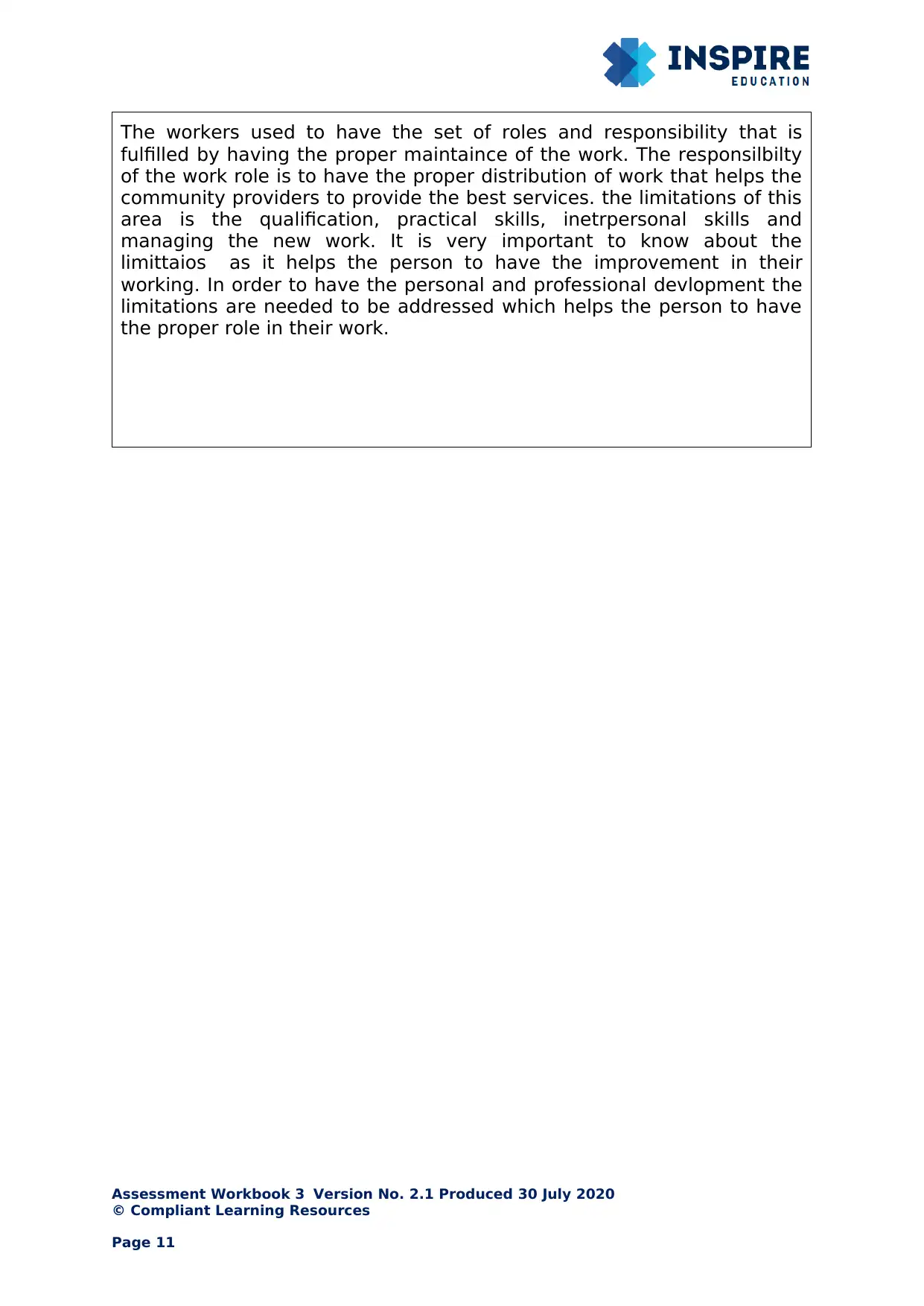
The workers used to have the set of roles and responsibility that is
fulfilled by having the proper maintaince of the work. The responsilbilty
of the work role is to have the proper distribution of work that helps the
community providers to provide the best services. the limitations of this
area is the qualification, practical skills, inetrpersonal skills and
managing the new work. It is very important to know about the
limittaios as it helps the person to have the improvement in their
working. In order to have the personal and professional devlopment the
limitations are needed to be addressed which helps the person to have
the proper role in their work.
Assessment Workbook 3 Version No. 2.1 Produced 30 July 2020
© Compliant Learning Resources
Page 11
fulfilled by having the proper maintaince of the work. The responsilbilty
of the work role is to have the proper distribution of work that helps the
community providers to provide the best services. the limitations of this
area is the qualification, practical skills, inetrpersonal skills and
managing the new work. It is very important to know about the
limittaios as it helps the person to have the improvement in their
working. In order to have the personal and professional devlopment the
limitations are needed to be addressed which helps the person to have
the proper role in their work.
Assessment Workbook 3 Version No. 2.1 Produced 30 July 2020
© Compliant Learning Resources
Page 11
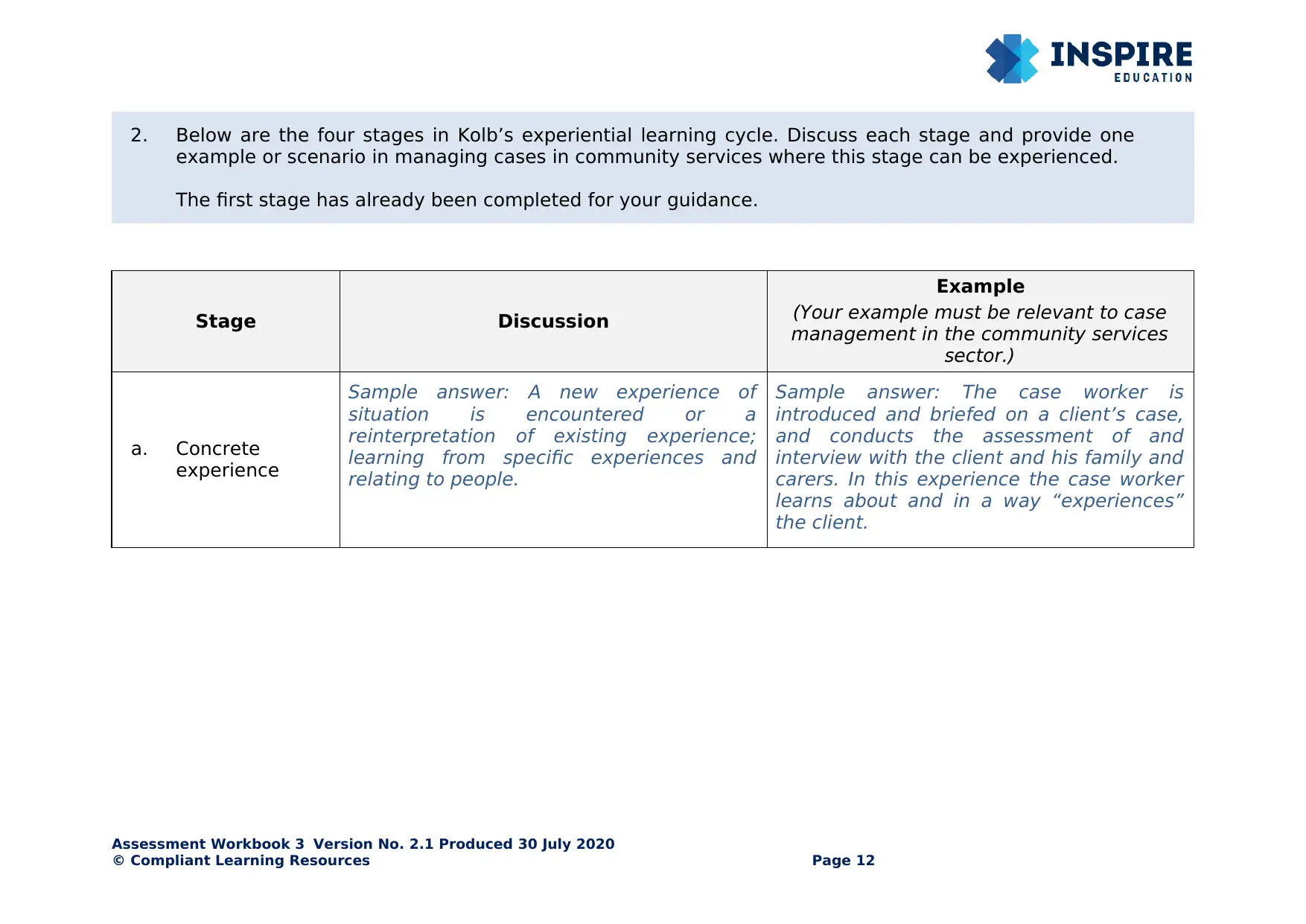
2. Below are the four stages in Kolb’s experiential learning cycle. Discuss each stage and provide one
example or scenario in managing cases in community services where this stage can be experienced.
The first stage has already been completed for your guidance.
Stage Discussion
Example
(Your example must be relevant to case
management in the community services
sector.)
a. Concrete
experience
Sample answer: A new experience of
situation is encountered or a
reinterpretation of existing experience;
learning from specific experiences and
relating to people.
Sample answer: The case worker is
introduced and briefed on a client’s case,
and conducts the assessment of and
interview with the client and his family and
carers. In this experience the case worker
learns about and in a way “experiences”
the client.
Assessment Workbook 3 Version No. 2.1 Produced 30 July 2020
© Compliant Learning Resources Page 12
example or scenario in managing cases in community services where this stage can be experienced.
The first stage has already been completed for your guidance.
Stage Discussion
Example
(Your example must be relevant to case
management in the community services
sector.)
a. Concrete
experience
Sample answer: A new experience of
situation is encountered or a
reinterpretation of existing experience;
learning from specific experiences and
relating to people.
Sample answer: The case worker is
introduced and briefed on a client’s case,
and conducts the assessment of and
interview with the client and his family and
carers. In this experience the case worker
learns about and in a way “experiences”
the client.
Assessment Workbook 3 Version No. 2.1 Produced 30 July 2020
© Compliant Learning Resources Page 12
⊘ This is a preview!⊘
Do you want full access?
Subscribe today to unlock all pages.

Trusted by 1+ million students worldwide
1 out of 52
Related Documents
Your All-in-One AI-Powered Toolkit for Academic Success.
+13062052269
info@desklib.com
Available 24*7 on WhatsApp / Email
![[object Object]](/_next/static/media/star-bottom.7253800d.svg)
Unlock your academic potential
Copyright © 2020–2025 A2Z Services. All Rights Reserved. Developed and managed by ZUCOL.





